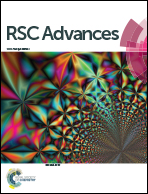Self-assembly of magnetically recoverable ratiometric Cu2+ fluorescent sensor and adsorbent
Abstract
A mesoporous shell containing a fluorescence resonance energy transfer (FRET) type of ratiometric Cu2+ fluorescent sensor was coated around a cetyltrimethylammonium bromide (CTAB) stabilized Fe3O4@SiO2 core. All of the units comprising the sensor composite, including the Cu2+ ligand, signal reference and reporter units, are independent of each other and without a direct covalent linkage between them, and are site-selectively self-assembled into the pore framework or channel of the mesoporous silica matrix through the electrostatic interaction between CTAB porogen and silicates. The coordination of Cu2+ and its ligand leads to the variation of fluorescence energy transfer efficiency between neighboring FRET pairs benefiting from the nanosized pore system of the mesoporous matrix, which finally results in the ratiometric detection of Cu2+. Investigation of Cu2+ adsorption performance indicated rapid removal efficiency, with a maximum adsorption capacity of 17.86 mg g−1. Fe3O4 nanoparticles were introduced as a core to make the sensor system magnetically recyclable after sensing and adsorption. Finally, the disassembly and reassembly of the Cu2+ sensor were achieved by extracting and reintroducing the units in CTAB micelles, making the sensing system reproducible.


 Please wait while we load your content...
Please wait while we load your content...